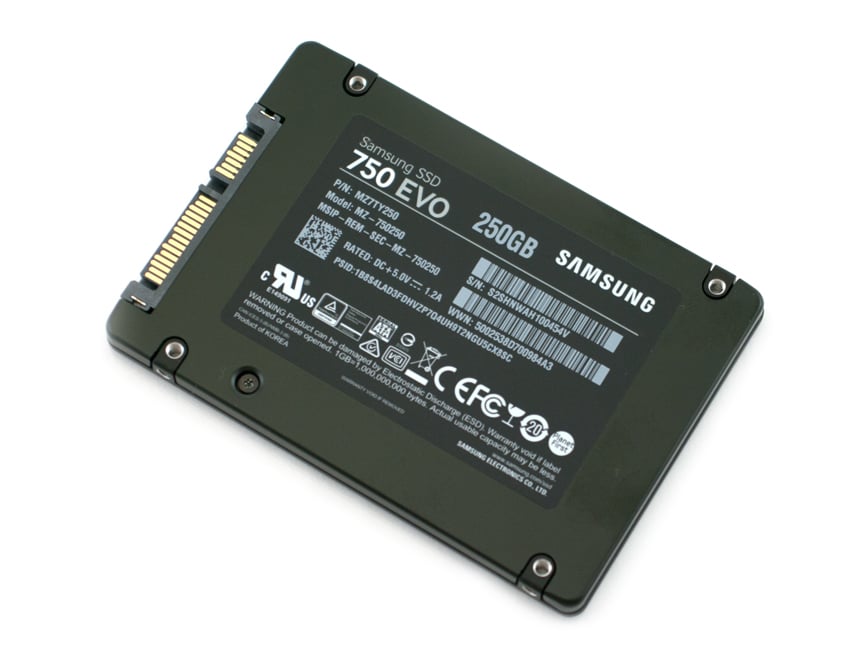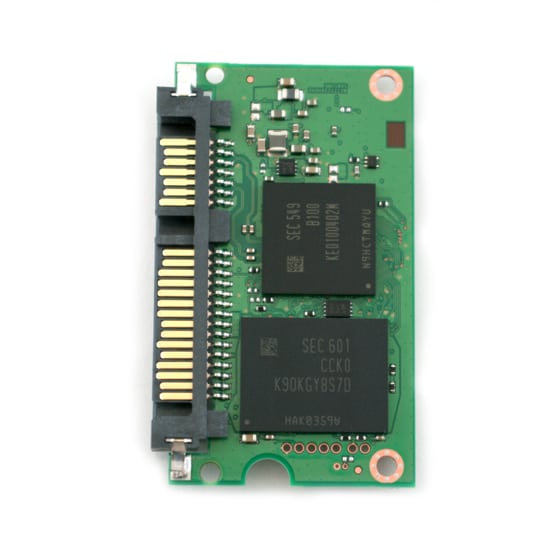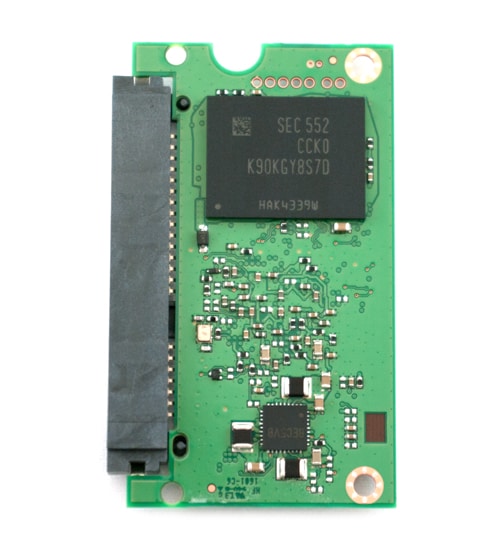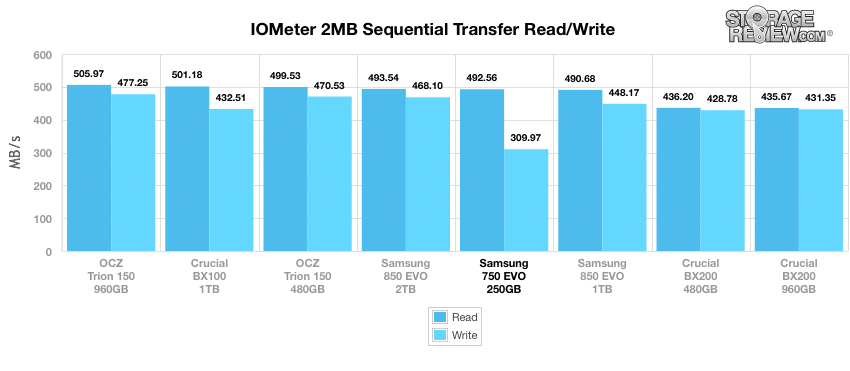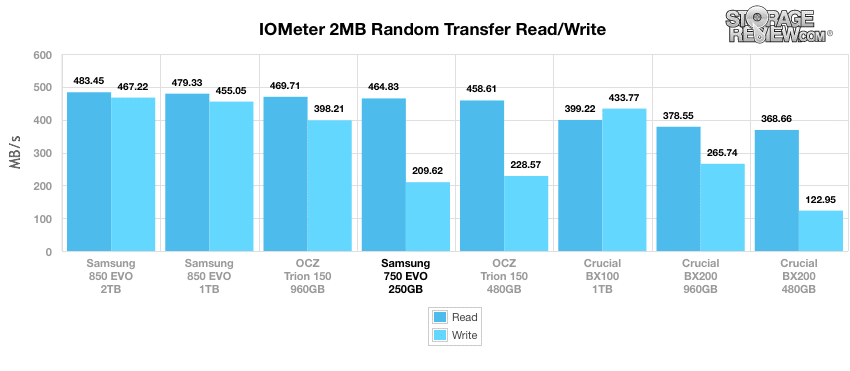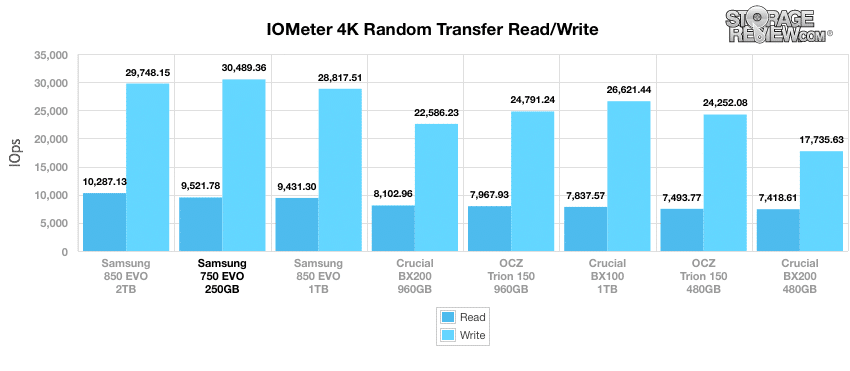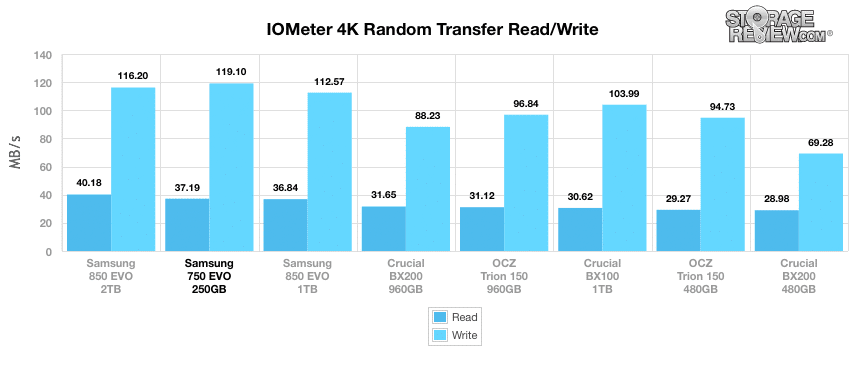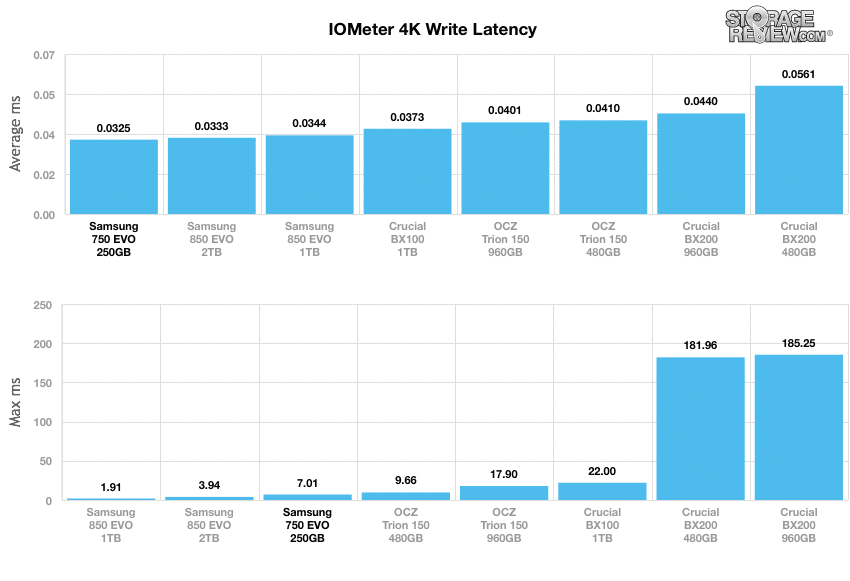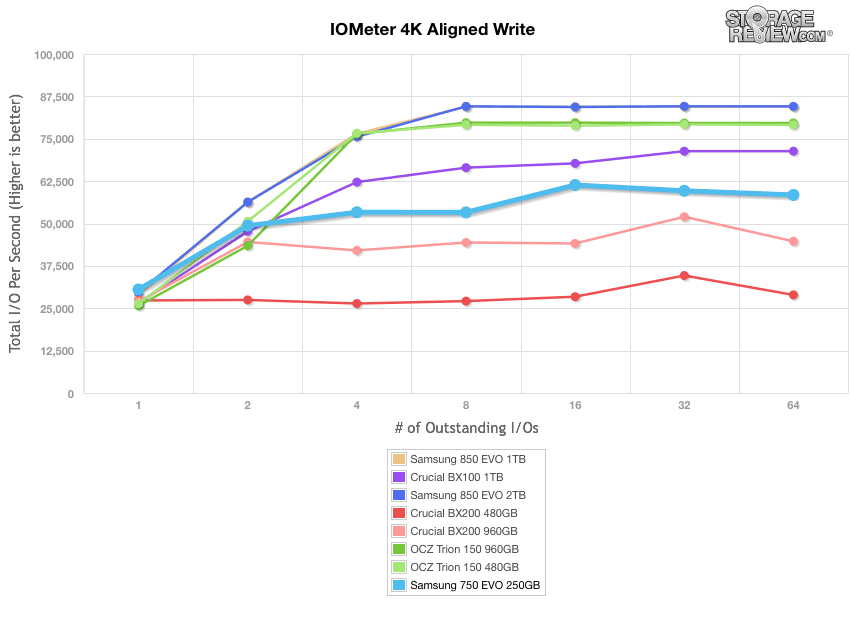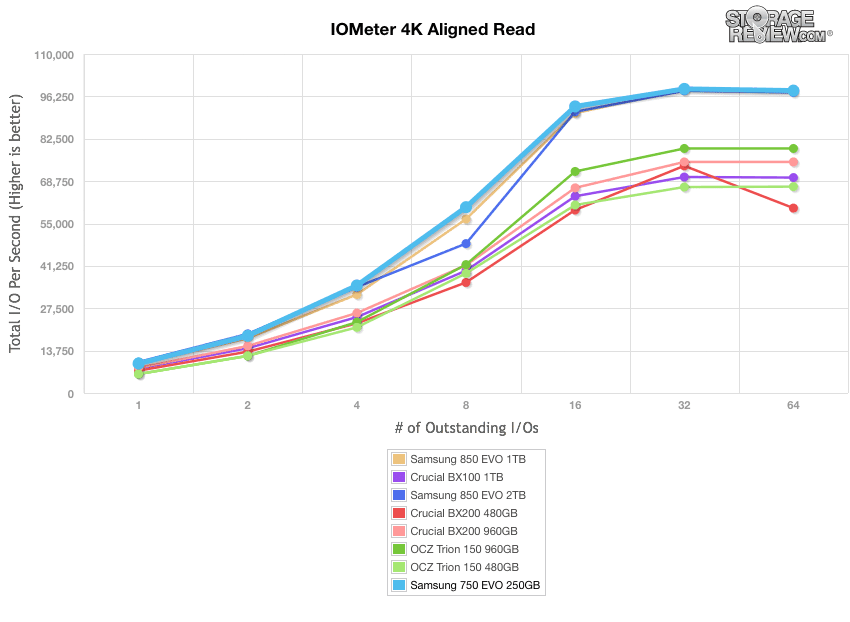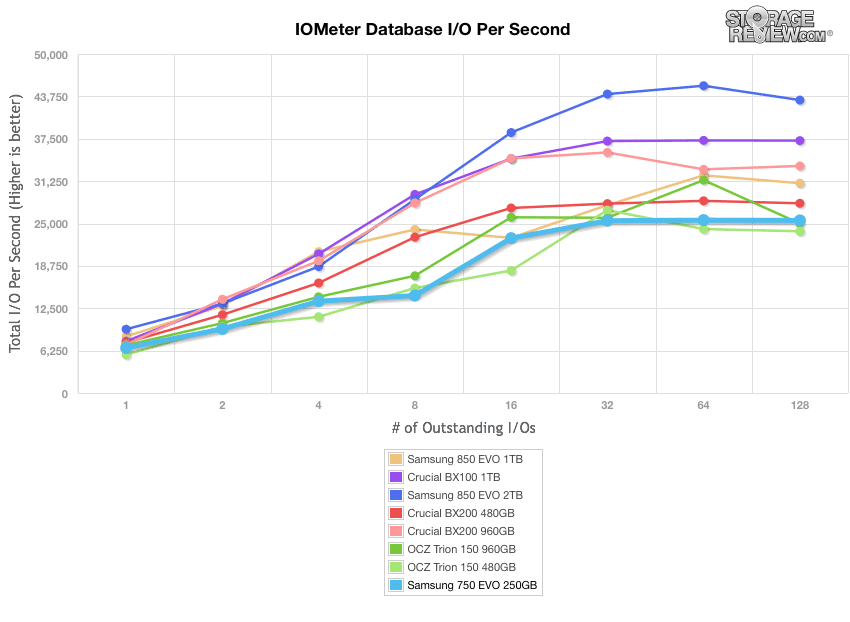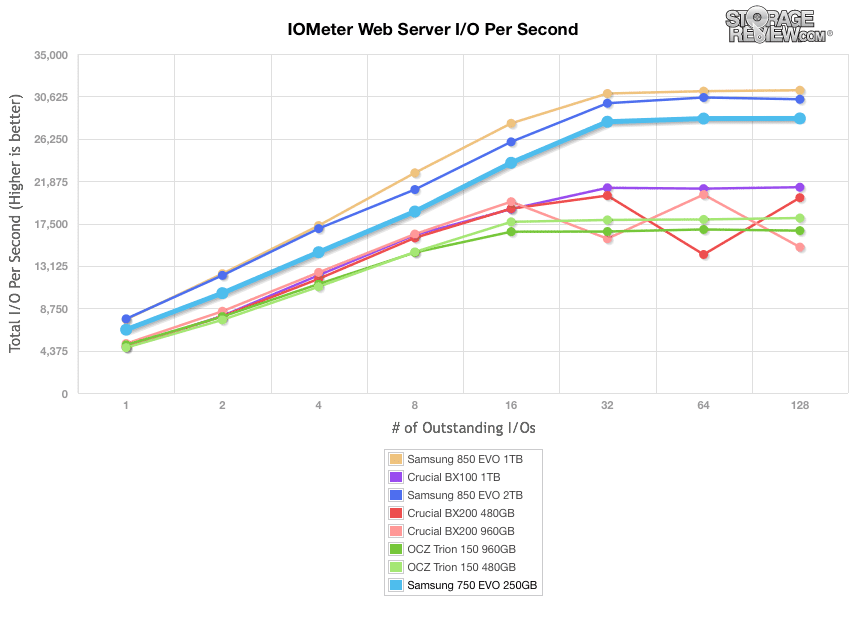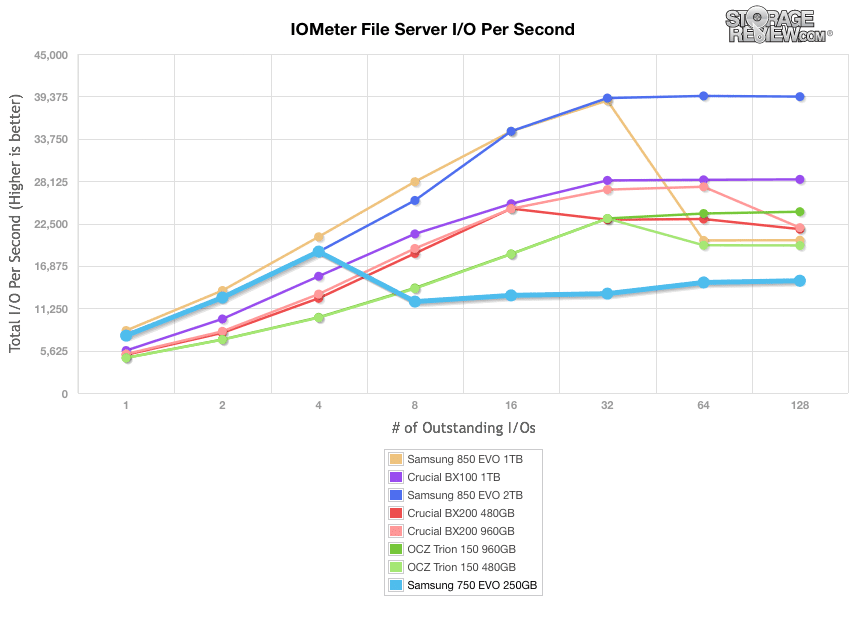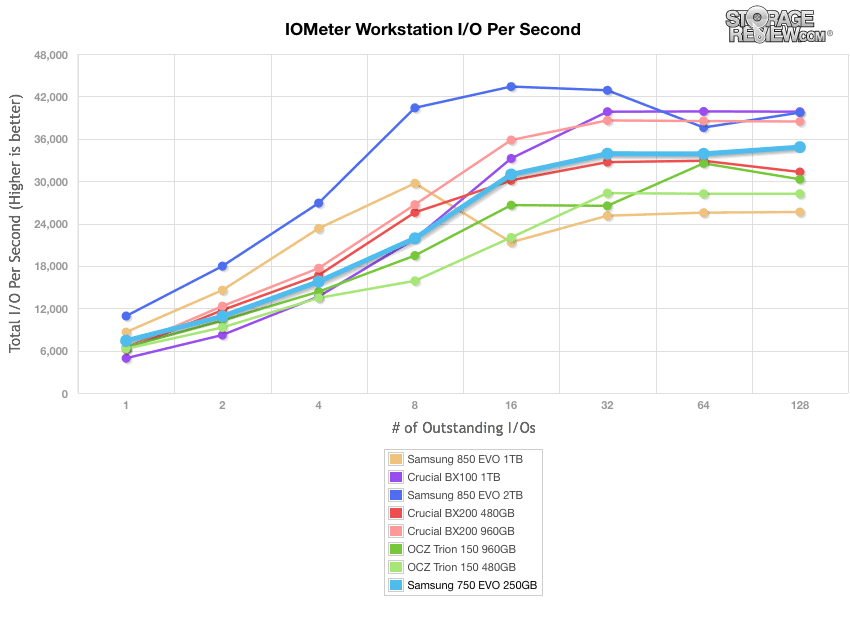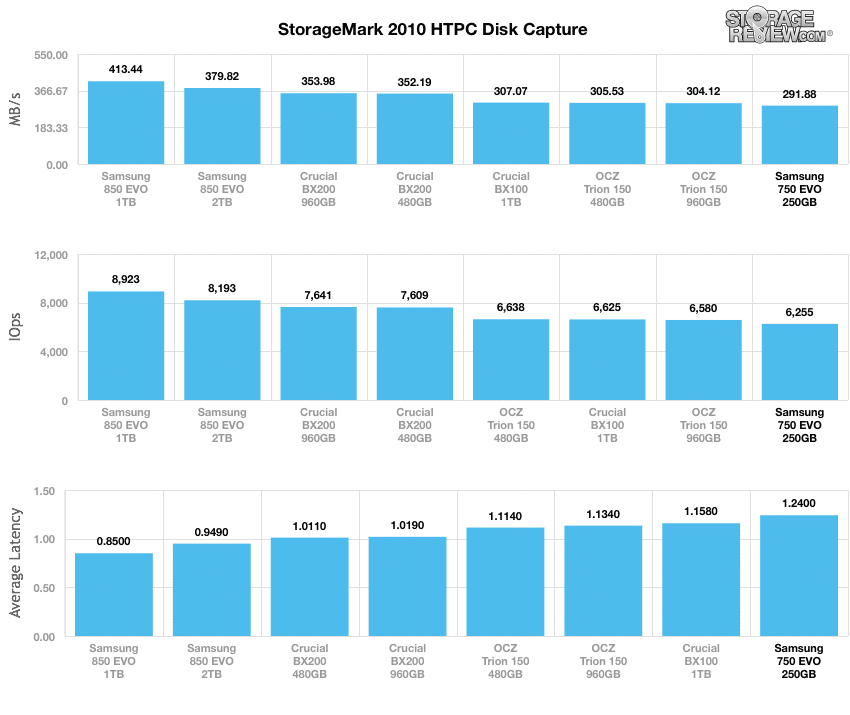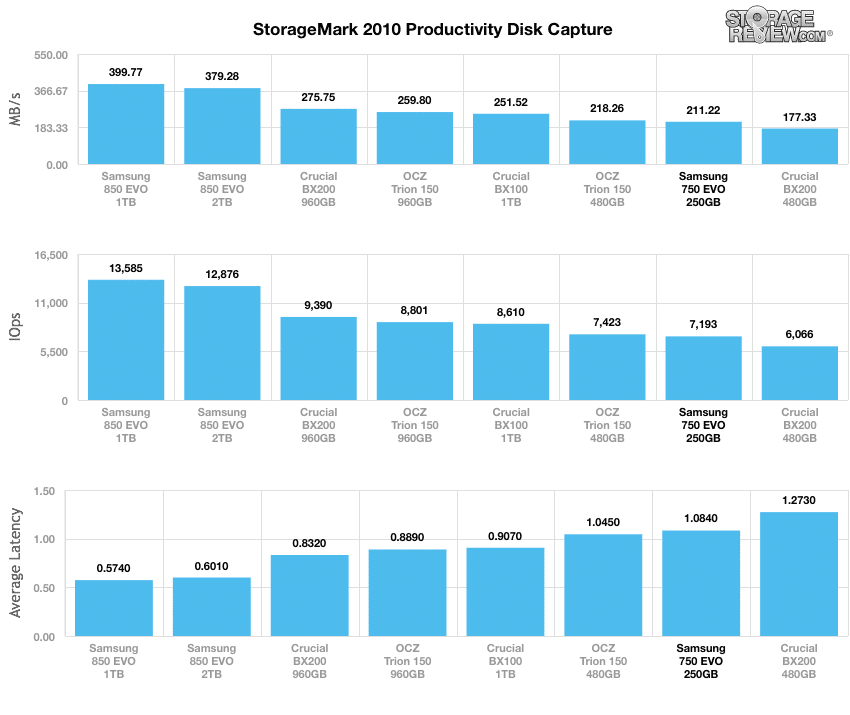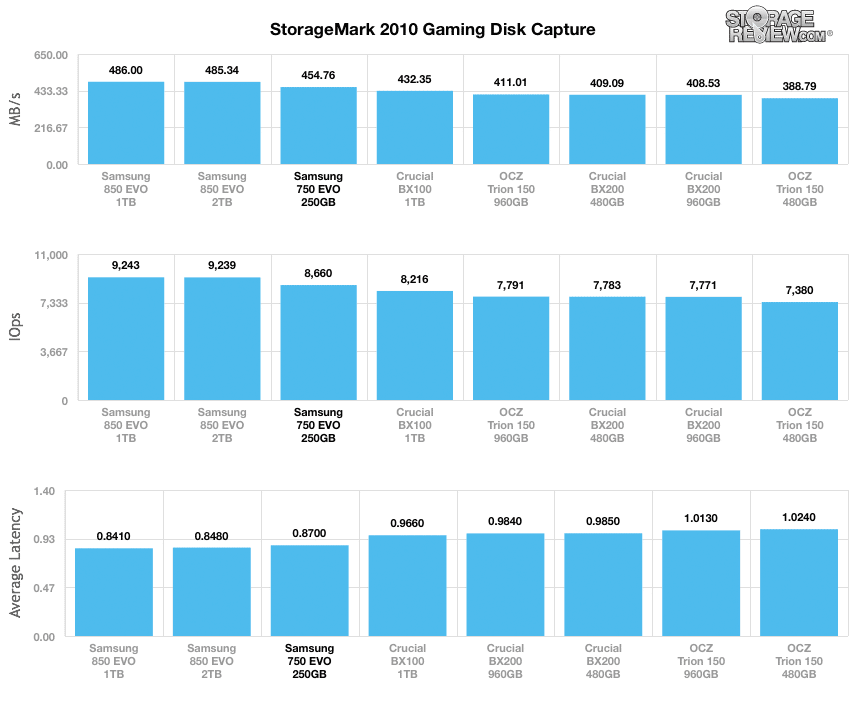
After being available in Asia for several months now, the Samsung EVO 750—the economical version of their impressive and very successful SSD line–has finally hit North American shores. The EVO 750 is designed to provide excellent performance and improve everyday computing experience at a lower price tag than the company’s 850 PRO and EVO lines, which will make this SSD an attractive option for many due to the company’s name coupled with its more budget looking cost. While the drive is available in retail markets in the US, the 750 EVO is designed primarily for OEMs and system integrators, giving them a low cost HDD alternative that still boasts a good performance profile and the other benefits of flash.
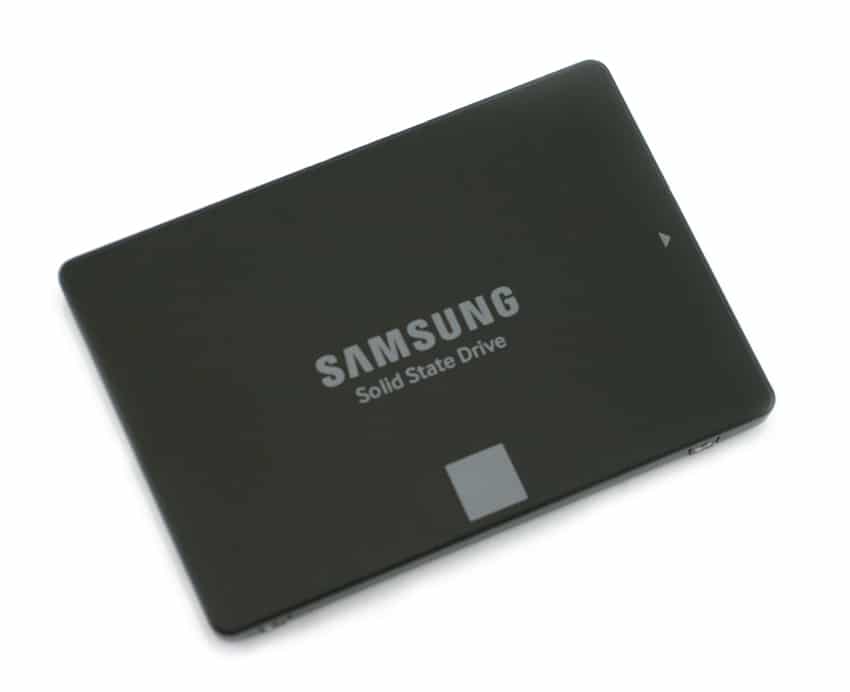
The 750 EVO comes equipped with the standard SATA 6 Gb/s interface and a tightly packed 256MB DDR3 memory module. And though it seems to be going the low-cost route with the company’s MGX controller and TLC NAND, Samsung still quotes very respectable sequential read and write speeds up to 540MB/s and 520MB/s, respectively, while random speeds are expected to reach 97,000 IOPS read and 88,000 IOPS write.
The 750 EVO features an AES-256-bit hardware-based full disk encryption engine, which helps secure data without too much of a hindrance in performance that is usually inherent with software-based encryption. The Samsung drive is also compliant with TCG 2 Opal v2.0 standards and IEEE 3.
The Samsung 750 EVO is backed by a 3-year warranty or 35 TBW for the 120GB model and 70 TBW for the 250 GB model, whichever comes first. We will be looking at the 250GB model in this review.
Samsung EVO 750 Specifications:
- Application: Client PCs
- Capacity: 120GB, 250GB
- Form Factor: 2.5 inch
- Interface: SATA 6Gb/s Interface, compatible with SATA 3Gb/s & SATA 1.5Gb/s interface
- Dimension (WxHxD): 100 X 69.85 X 6.8 (mm)
- Weight: Max 45.0g
- NAND Type: Samsung NAND Flash Memory
- Controller: Samsung MGX controller
- Cache Memory: Samsung 256MB DDR3 DRAM
- Special Features:
- TRIM Support
- S.M.A.R.T Support
- Auto Garbage Collection Algorithm
- Encryption Support: AES 256-bit Full Disk Encryption (FDE) TCG/Opal v2.0, Encrypted Drive (IEEE1667)
- WWN Support
- Device Sleep Mode Support
- Performance
- Sequential Read: Up to 540 MB/sec
- Sequential Write: Up to 520 MB/sec
- Random Read (4 KB, QD 32):
- Up to 94,000 IOPS (120GB)
- Up to 97,000 IOPS (250GB)
- Random Write: (4 KB, QD 32)
- Up to 88,000 IOPS (120GB)
- Up to 88,000 IOPS (250GB)
- Random Read (4 KB, QD 1):
- Up to 10,000 IOPS (120GB)
- Up to 10,000 IOPS (250GB)
- Random Write (4 KB, QD 1):
- Up to 35,000 IOPS (120GB)
- Up to 35,000 IOPS (250GB)
- Environment
- Power Consumption:
- 120GB:
- Active Read/Write (Average): 2.1W / 2.4W
- Idle: 50mW
- Device Sleep: 6mW
- 250GB:
- Active Read/Write (Average): 2.4W / 2.8W,
- Idle: 50mW
- Device Sleep: 6mW
- 120GB:
- Power Consumption:
- Reliability (MTBF): 1.5 Million Hours Reliability (MTBF)
- Operating Temperature: 0 °C to 70 °C (Measured by SMART Temperature. Proper airflow recommended)
- Shock: 1500G, duration 0.5m sec, 3 axis
- Software:
- Management SW
- Magician Software for SSD management
- Warranty: 3 Year Limited Warranty or 35TBW Limited Warranty (Whichever comes first)
Design and Build
The Samsung 750 EVO looks virtually identical to its 850 EVO and PRO brethren (save a few differences in color) focusing on a minimalistic design. The enclosure consists of a slim black and grey design, with simple Samsung branding and “Solid State Drive” text. It is of 7mm z-Height form factor, which enables it to support almost any OEM use case.
The back side of the drive over shows a sticker that has all the important information about the drive. As is the norm, the side profiles come with four screw holes for seamless mounting.
Once the cover is removed, you will see the very, very compact PCB board. Visible is the Samsung V-NAND as well as the Samsung MGX controller.
The EVO 750 supports SATA 6Gb/s interface; however, it is backwards compatible with SATA 3Gb/s and SATA 1.5Gb/s.
Consumer Synthetic Benchmarks
All consumer SSD benchmarks are conducted with the StorageReview HP Z620 Workstation. We compared the Samsung EVO 750 with the following drives:
- Samsung 850 EVO 2TB (SATA, 6Gb/s, Samsung MHX controller)
- Samsung 850 EVO 1TB (SATA, 6Gb/s, Samsung MEX controller)
- Crucial BX100 1TB (SATA, 6Gb/s, Silicon Motion SM2246EN controller)
- Crucial BX200 480TB (SATA, 6Gb/s, Silicon Motion SM2256 controller)
- Crucial BX200 960TB (SATA, 6Gb/s, Silicon Motion SM2256 controller)
- OCZ Trion 150 960GB (SATA, 6GB/s, Toshiba controller)
- OCZ Trion 150 480GB (SATA, 6GB/s, Toshiba controller)
All IOMeter figures are represented as binary figures for MB/s speeds.
Our first test measures 2MB sequential performance. In this scenario, the 250TB Samsung 750 EVO boasted impressive read speeds at 492.56MB/s, which placed it just behind the Samsung 850 EVO 2TB and above the 1TB model. That being said, it did boast the weakest writing performance by a significant margin (309.97MB/s).
Moving to our 2MB random transfer performance, the 750 EVO slowed down just a tad, ranking at upper middle of our leaderboard with read and writes of 464.83MB/s and 209.62MB/s, respectively. The Samsung 850 EVO 2TB with 483.45MB/s in reads.
In IOMeter’s random 4K read and write, the 750 EVO drive measured in at an impressive 37.19MB/s read and 119.1MB/s, which was just behind the Samsung 850 EVO 2TB in reads and the top performer in writes.
Results were mirrored when looking at our random 4k performance, which pushes hard on the drives when looking at throughput. Again, the 750 EVO found itself just behind the 850 EVO 2TB with an impressive 9,521.78 IOPS read and taking top spot in writes with 30,489.36 IOPS write.
When comparing write latency, the 750 EVO posted the best average latency with just 0.03253ms in reads while its maximum writings were impressive as well, posting just 7.0091ms, trailing just the two 850 EVO capacities.
In our next 4K test, we move to a workload with 100% write activity, which scales from 1QD to 64QD. In the aligned write setting, the 750 EVO posted results that placed it near the bottom of the leaderboard (even with top initial speed) with 30,532.90 IOPS in burst and 58,420.50 IOPS in the terminal.
Things picked up significantly when looking at the aligned read results. Here, it boasted an impressive range of 9,559.13 IOPS burst and 98,127.98232 IOPS in the terminal, which placed it just behind the Samsung 850 EVO 1TB (98,491.28 IOPS in the terminal).
Our final consumer synthetic benchmarks compare the drives in a series of mixed server workloads with a queue depth from 1 to 128. Each server profile has a strong bias towards read activity, ranging from 67% read with the database profile to 100% read in the web server profile.
The database profile features a 67% read and 33% write workload focusing on transfers around 8K in size. In this scenario, the 750 EVO recorded middle-of-the-run results with a range of 6,667.81 IOPS to 25,453.04 IOPS in the terminal. The top performer here was the Samsung 850 EVO 2TB.
Our next benchmark is the web server profile is read-only with transfer sizes ranging from 512B to 512KB. Here, the 750 EVO performed much better, with 28,346.94515 IOPS by the end of the test, which trailed just the Samsung 850 EVO drives for top spot.
The file server profile has 80% read and 20% write workload spread out over multiple transfer sizes ranging from 512-byte to 64KB. The Samsung 750 EVO recorded the slowest results with a range of just 7,613.41 IOPS and 14,902.86 IOPS.
The last profile looks at workstation activity, with a 20% write and 80% read mixture using 8K transfers. Here, the 750 EVO recorded a decent range in IOPS with 7,402.62 through 34,816.94.
Consumer Real-World Benchmarks
While the results of synthetic benchmarks are important to identify the key strengths and weaknesses of a drive, performance in these tests does not always translate directly into real-world situations. To get a better idea how the Samsung 750 EVO will handle itself in the field we will chart StorageMark 2010 HTPC, Productivity, and Gaming traces against comparable drives. Higher IOPS and MB/s rates with lower latency times are preferred.
The first traced is based on use as a Home Theater PC (HTPC). The test includes playing one 720P HD movie in Media Player Classic, one 480P SD movie playing in VLC, three movies downloading simultaneously through iTunes, and one 1080i HDTV stream being recorded through Windows Media Center over a 15 minute period.
In our HTPC profile, the 750 EVO SSD was certainly outclassed, recording results that placed it at the bottom of the pack with 6,255.25 IOPS 291.88MB/s and 1.24ms in average latency. Its Samsung 850 EVO 1TB cousin was the top performer here.
The next trace simulates disk activity in an office workstation or productivity scenario. This test includes three hours of operation in an office productivity environment with 32-bit Windows Vista running Outlook 2007 connected to an Exchange server, web browsing using Chrome and IE8, editing files within Office 2007, viewing PDFs in Adobe Reader, an hour of local music playback, and two hours of streaming music via Pandora.
In our Productivity trace, the Samsung 750 EVO posted 7,193.46IOPS, 211.22MB/s, and 1.084ms in average latency. This place it near the bottom of the pack and just above the Crucial BX200 480GB.
The final consumer real-life benchmark simulates disk activity during gaming. This simulation taxes the drive’s read performance, with 6% write operations and 94% read operations. The test consists of a Windows 7 Ultimate 64-bit system pre-configured with Steam, with Grand Theft Auto 4, Left 4 Dead 2, and Mass Effect 2 already downloaded and installed. The trace captures the heavy read activity of each game loading from the start, as well as textures as the game progresses.
In this gaming profile, the 750 EVO picked up its performance significantly posting a very respectable 8,660.19 IOPS, 454.76MB/s, and 0.87ms in average latency. These results placed it in the upper middle part of the leaderboard.
Conclusion
The Samsung 750 EVO certainly works well as the company’s budget alternative to their hugely successful SSDs in EVO and PRO lines. Though not as low-cost as drives like Crucial’s BX200, the 750 EVO does offer OEMs an inexpensive way to upgrade PCs and laptops from either hard disk rigs or those with SSDs that are less reliable. Boasting a 2.5″ (7mm) form factor and a 256MB DDR3 memory module, Samsung’s new SSD line feature a SATA 6Gb/s interface, Samsung TLC NAND, an MGX Controller and features easy-to-use installation software; however, it would have been nice to see a few more higher capacities added to the line. While it can be found on markets such as Amazon, the EVO 750 is not aimed at general consumers or as a SSD upgrade, it’s largely designed for OEMs and system integrators.
As far as the specifics of its performance go, it was a mixed bag and certainly not as consistent as Samsung’s 850 line; it struggled in certain areas and excelled in others. On of the examples of the latter was during our 2MB sequential benchmark where the 250TB Samsung 750 EVO boasted impressive read speeds at 492.56MB/s, placing it just behind the Samsung 850 EVO 2TB and above the 1TB model; however, it recorded the weakest write performance by a significant margin with 309.97MB/s. The random workload told a similar story, ranking at upper middle of our leaderboard with 464.83MB/s read and 209.62MB/s write.
Looking at the IOMeter in random 4K read and write, the 750 EVO drive recorded an impressive 37.19MB/s read and 119.1MB/s, which was a tad behind the first place Samsung 850 EVO 2TB in reads, though it did boast the write performance. Results were virtually the same when looking at our random 4k performance, where the 750 EVO found itself just behind the 850 EVO 2TB with a very respectable 9,521.78 IOPS read all the while taking top spot in writes once again with 30,489.36 IOPS. In the aligned write setting, however, the new Samsung drive placed it near the bottom of the pack with 30,532.90 IOPS in burst and 58,420.50 IOPS in the terminal. In our final consumer synthetic benchmarks, which tested mixed server workloads with a queue depth from 1 to 128, the 750 EVO showed inconsistent results again. For example, the Samsung drive recorded subpar performance in our the database profile, ranging from of 6,667.81 IOPS to just 25,453.04 IOPS in the terminal; however, the 750 EVO performed much better during our web server profile with a maximum IOPS of 28,346.95, which trailed only the Samsung 850 EVO drives for top spot
In our real-world consumer benchmarks, the 750 EVO SSD was outclassed during our HTPC and Productivity traces, recording results that placed it at the bottom of the pack by a significant margin and coming nowhere near its 850 EVO brethren. That being said, the 750 EVO picked up its performance significantly in our gaming profile, posting a respectable 8,660.19 IOPS, 454.76MB/s, and 0.87ms in average latency, placing it the middle part of the leaderboard.
Overall, it the Samsung 750 EVO performed as expected and was pretty much in line with other drives of its class. For roughly $65 on Amazon, you will be able to pick up the 120GB model if you so choose, though as noted, this is really designed more as an HDD alternative for system vendors.
Pros
- Strong read performance in most of our tested benchmarks
- Bundled data migration software and AES-256-bit hardware-based full disk encryption engine
- Great features for first-time SSD buyers
Cons
- Only 120GB and 250GB capacities
- Mixed performance with write-intensive workloads
Bottom Line
Though it would have been nice to see larger capacities, the Samsung 750 EVO offers the company’s pedigree in reliability at a low price point, making it an attractive option for many OEMs looking for an alternative entry-SSD replacement for HDDs.

